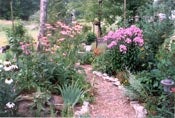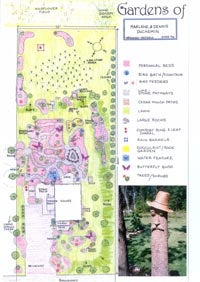
Travel a little south of Ontario’s Muskoka region and you’ll come to the home of Marlene and Dennis DuChemin. Their property, in gardening zone 4b, is lovingly tended, primarily by Marlene, who uses her garden as a place for welcoming their wild neighbours and expressing her artistic flair.
Marlene’s desire for a safe garden environment and beautiful surroundings naturally resulted in providing the four basic elements that support wildlife — food, water, shelter and space. This, in addition to gardening without chemicals and incorporating native plants, allows wildlife to thrive. It also means that the DuChemins were eligible to be certified by CWF’s Backyard Habitat Certification program.

When Marlene and Dennis first purchased their property in 1975, the yard consisted of sand fill, patchy grass and a few trees. “However,” Marlene confesses, “being an amateur artist and floral designer, it didn’t take long to start adorning our yard bit by bit. The more trees we planted, the more birds we noticed.” Marlene took horticultural courses and found that her growing knowledge and increased wildlife sightings fuelled her interest and desire in further developing her garden. A very noticeable feature of the DuChemins’ garden is the myriad paths that wind through it. Some are grass, some are stone, while others are made from wood chips. The paths pass by garden beds filled with countless perennials, including some natives like black-eyed Susan (Rudbeckia hirta) and obedient plant (Physostegia virginiana). These, along with many of their shrubs and trees, provide nectar for beneficial insects like bees, butterflies and those that eat unwanted bugs. After the flowers turn to seeds or fruit, they feed the birds and mammals. These plants also give invaluable shelter from the sun, wind, snow and predators, and give small creatures a place to nest and perch. “Native plants,” adds Marlene, “are usually hardier and pest-free.”
This natural food source is supplemented with bird feeders — both the seed and suet kinds. They hang orange halves in onion mesh bags for the orioles to nibble and hang feeders for hummingbirds as a backup to the flowers they primarily feed from.

The DuChemins also let their home serve as supplemental shelter for some bats, which live behind their window shutters. Knowing they will eat hundreds of mosquitoes and adult ”pest species,” such as cucumber beetles, cutworm, corn earworm, leafhoppers and June beetles, makes them a worthy ally.
The garden boasts several water features, ranging from birdbaths to a small pond next to the deck. Birds and other creatures, such as the DuChemins’ one-eyed bullfrog, make good use of this water for drinking, hiding, washing and cooling down on a hot summer day.
Marlene employs different methods to keep weeds in check, depending on where they sprout. She will use mulch to prevent them from growing and casually pulls out the odd one that pops through. Other times she uses her hoe — and sometimes she just lets them blend in. Marlene plants densely and, in the lawn, overseeds where needed.

The DuChemins have several composters, which they use to nourish plants and improve the soil structure. Their many rain barrels help conserve water. By not cutting their lawn too short, the grass roots and leaves are able to resist heat and pests — and they never water the lawn.
Marlene credits her success to a few key elements. She learned as much as she could about plant material and chose plants according to their height at maturity. She puts plants together with complementary foliage colours and textures, as well as different blooming times, so there is always something of visual interest showing in the garden. Marlene also employs an age-old method that has been useful for athletes and artists alike — she pictures ways she would create her garden projects before physically engaging herself.
Marlene’s success can be measured by her reward of singing birds, colourful butterflies and a vibrant garden.
If you want to find out more about CWF’s Backyard Habitat Certification program, use the search words “certify your backyard” for an application form.
